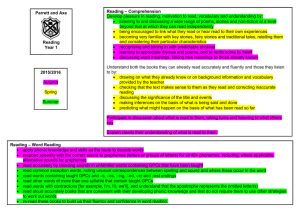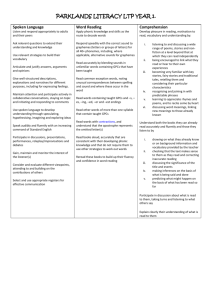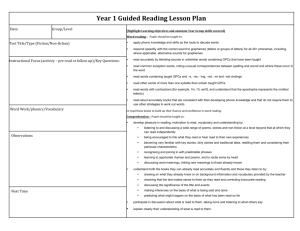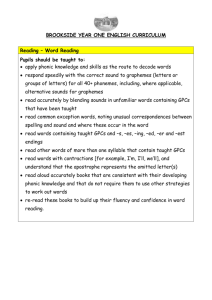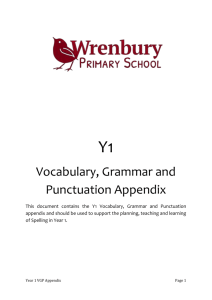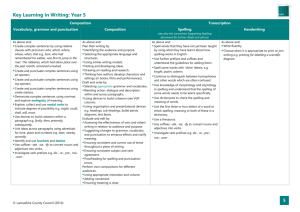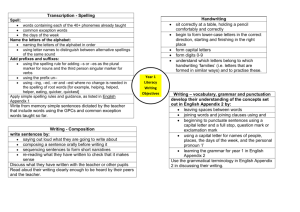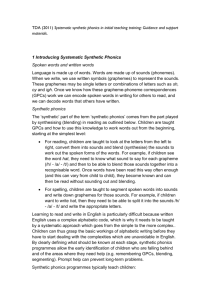Curriculum Map of Key Skills
advertisement
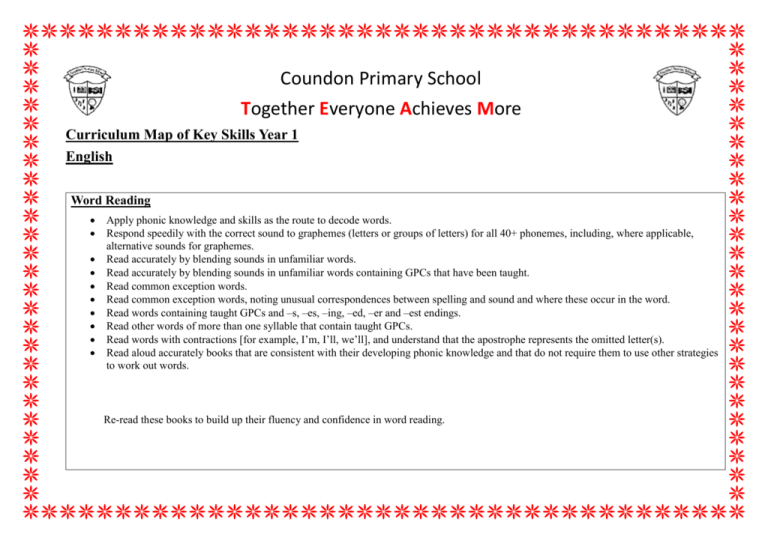
Coundon Primary School Together Everyone Achieves More Curriculum Map of Key Skills Year 1 English Word Reading Apply phonic knowledge and skills as the route to decode words. Respond speedily with the correct sound to graphemes (letters or groups of letters) for all 40+ phonemes, including, where applicable, alternative sounds for graphemes. Read accurately by blending sounds in unfamiliar words. Read accurately by blending sounds in unfamiliar words containing GPCs that have been taught. Read common exception words. Read common exception words, noting unusual correspondences between spelling and sound and where these occur in the word. Read words containing taught GPCs and –s, –es, –ing, –ed, –er and –est endings. Read other words of more than one syllable that contain taught GPCs. Read words with contractions [for example, I’m, I’ll, we’ll], and understand that the apostrophe represents the omitted letter(s). Read aloud accurately books that are consistent with their developing phonic knowledge and that do not require them to use other strategies to work out words. Re-read these books to build up their fluency and confidence in word reading. Comprehension Develop pleasure in reading, motivation to read, vocabulary and understanding by: listening to and discussing a wide range of poems, stories and non-fiction at a level beyond that at which they can read independently; being encouraged to link what they read or hear read to their own experiences; becoming very familiar with key stories, fairy stories and traditional tales; retelling key stories, fairy stories and traditional tales considering their particular characteristics; recognising and joining in with predictable phrases; learning to appreciate rhymes and poems; recite some rhymes and poems by heart; discussing word meanings, linking new meanings to those already known. Understand both the books they can already read accurately and fluently and those they listen to by: drawing on what they already know or on background information and vocabulary provided by the teacher; checking that the text makes sense to them as they read; as they read correcting inaccurate reading; discussing the significance of the title and events; making inferences on the basis of what is being said and done; predicting what might happen on the basis of what has been read so far. Participate in discussion about what is read to them, taking turns and listening to what others say. Explain clearly their understanding of what is read to them. Writing Transcription – Handwriting Sit correctly at a table, holding a pencil comfortably and correctly. Begin to form lower-case letters in the correct direction, starting and finishing in the right place. [‘c’ shapes start at top and are made anti-clockwise, no letter starts at the bottom.] Form capital letters. Form digits 0-9. Understand which letters belong to which handwriting ‘families’ (i.e. letters that are formed in similar ways) and to practise these. Composition Write sentences by: saying out loud what they are going to write about; composing a sentence orally before writing it; sequencing sentences to form short narratives; re-reading what they have written to check that it makes sense. Discuss what they have written with the teacher or other pupils. Read aloud their writing clearly enough to be heard by their peers and the teacher. Vocabulary, Grammar and Punctuation Transcription – Spelling Spelling revision from EYFS: • all letters of the alphabet and the sounds which they most commonly represent; • consonant digraphs which have been taught and the sounds which they represent; • vowel digraphs which have been taught and the sounds which they represent; • the process of segmenting spoken words into sounds before choosing graphemes to represent the sounds; • words with adjacent consonants; • guidance and rules which have been taught. words containing each of the 40+ phonemes already taught; common exception words; the days of the week. Name the letters of the alphabet: naming the letters of the alphabet in order; using letter names to distinguish between alternative spellings of the same sound. Spell: Add prefixes and suffixes: using the spelling rule for adding –s or –es as the plural marker for nouns and the third person singular marker for verbs; using the prefix un–; using –ing, –ed, –er and –est where no change is needed in the spelling of root words [for example, helping, helped, helper, eating, quicker, quickest]. Apply simple spelling rules and guidance, as listed in English Appendix 1. Write from memory simple sentences dictated by the teacher that include words using the GPCs and common exception words taught so far. Vocabulary, Grammar and Punctuation Develop their understanding of the concepts set out in English (Year 1): Word Regular plural noun suffixes –s or –es (eg, dog, dogs; wish, wishes), including the effects of these suffixes on the meaning of the noun. Suffixes that can be added to verbs where no change is needed in the spelling of root words (eg, helping, helped, helper). How the prefix un– changes the meaning of verbs and adjectives (negation, eg, unkind, or undoing, eg, untie the boat). Sentence How words can combine to make sentences. Joining words and joining clauses using and. Text Sequencing sentences to form short narratives. (also in composition) Punctuation Separation of words with spaces; Introduction to capital letters, full stops, question marks and exclamation marks to demarcate sentences. Capital letters for names and for the personal pronoun ‘I.’ Terminology for pupils Use the grammatical terminology in English Appendix 2 in discussing their writing (letter, capital letter, word, singular, plural, sentence, punctuation, full stop, question mark, exclamation mark). Mathematics 1 Is able to read and write numbers from 1 – 20 in numerals and words e.g. can write all digits from 1 – 20 correctly as well as write numbers such as ‘seven’ as a digit or as a word. 2 Is able to count, read and write numbers to 100 e.g. can count up to 100 in ‘ones’ and can write ‘27’ correctly and not write it as ‘72’. 3 Is able to count to and across 100, forwards and backwards beginning from 0 or 1 or from any given number e.g. can count backwards from 98 and stop at 81 or count forwards from 17 and stop at 30 etc. 4 Can count in multiples of 2, 5 and 10 e.g., 2, 4, 6, 8, 10, 12 etc. or in multiples of 5 e.g. 5, 10, 15, 20 , 25 etc. 5 Is able to give one more or one less than a given number e.g. can write one more than 26 or one less that 71 6 Is able to identify and represent numbers using objects and pictorial representations e.g. can show what 5 looks like in a given context e.g. 5 cars or 5 ‘lollypops’ 7 Can represent and use number bonds and related subtraction facts within 20 e.g. know that 5 = 4 + 1 or 3+2 or 1 + 4 and that 15 = 10 + 5 or 12 + 3 etc. 8 Is able to add and subtract one-digit and two-digit numbers to 20, including zero e.g. know that 4 + 3 = 7 and 17 – 4 = 13 and 4 = 17 – 13 as well as know the effect of adding or subtracting zero e.g. 16 + 0 = 16 or 17 – 0 will still equal 17. 9 Is able to solve missing number problems e.g. 15 – ‘x’ = 11 or 9 = 3 + ‘x’. 10 Is able to read write and interpret the symbols involving addition (+) subtraction (-) and equals (=) 11 Is able to share small quantities e.g. be able to share 12 sweets between 4 children and recognise that each child would ‘get’ 3 sweets each. 12 Is able to group small quantities e.g. know that 4 groups of ‘2’ counters will total 8 counters or 5 groups of 3 cars will result in there being 15 cars. 13 Is able to double amounts and quantities e.g. can calculate ‘double 3’; ‘double 6’ and also ‘double 2’. 14 Can recognise, find and name a half as one of two equal parts, shape or quantity e.g. is able to shade a half of a shape such as a square or a half of a circle as well as know that half of 6 equals 3; half of 8 equals 4 etc. 15 Can recognise, find and name a quarter as one of four equal parts, shape or quantity e.g. is able to shade a quarter of a shape such as a square or a half of a circle as well as know that one quarter of 12 is 3 and ¼ of 20 is 5 etc. 16 Is able to tell the time to the hour and half past the hour and also draw the hands on a clock face to show the times e.g. recognises all ‘o’clock times’ and is able to highlight on a clock and also tell ‘half past the hour’ times’ e.g. half past 5 17 Can recognise and knows the value of different denominations of coins and notes 18 Can measure and begin to record: length and height, mass/weight, capacity and volume, time e.g. beginning to use scales to weigh ‘things’ such as a bag of apples being ‘2 kilograms’ or measure the length of ‘something’ with a metre stick e.g. the room is 3 metres long. Science 19 Is able to recall the days of the week and months of the year e.g. know the days of the week and can respond to ‘what is the day after Friday called?’ 20 Can recognise and name common 2-D and 3-D shapes e.g. such as circles, squares and triangles (2D shapes) and pyramids, cubes and cuboids (3D shapes) 21 Is able to describe position, direction and movement e.g. forwards, backwards, near, close and far, left and right etc. 22 Is able to compare and describe length and height e.g. able to use vocabulary such as long, longer and the longest 23 Is able to compare and describe mass / weight e.g. able to use vocabulary such as heavy, heavier and the heaviest or light and the lightest etc. 24 Is able to compare and describe capacity and volume e.g. able to use vocabulary such as full, empty and half full as well as more than and less than etc. 25 Is able to compare and describe time e.g. able to use vocabulary such as quicker and slower as well as earlier and later etc. Autumn Term -Plants Help children identify & name a variety of common wild & garden plants, including trees. Name & draw the main parts of a range of plants. Children grow their own flowers & vegetables from seed & harvest the food to eat! Study plant changes through the seasons. Autumn Term – Animals including humans Children name human body parts & senses & compare them with those of common animals. Draw pictograms using data about differences between children, e.g. hair colour & discuss the needs of pets. Autumn Term – Seasonal Changes Children find out facts about the Sun & observe its apparent movement across the sky. They investigate how shadows change during the day. Discuss the four seasons & varied day length. Describe the weather associated with each season & the changes this brings. Spring Term - Everyday Materials Explore commonly found materials & describe some of their properties, including whether they are natural or man-made. Use 3 Little Pigs to study building materials before relating properties of materials to their uses. Look in detail at paper & floating. Summer Term – Animals Collect, draw, label & identify minibeasts & visit a local farm.
